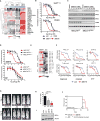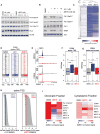BET Bromodomain Proteins Function as Master Transcription Elongation Factors Independent of CDK9 Recruitment
- PMID: 28673542
- PMCID: PMC5663500
- DOI: 10.1016/j.molcel.2017.06.004
BET Bromodomain Proteins Function as Master Transcription Elongation Factors Independent of CDK9 Recruitment
Abstract
Processive elongation of RNA Polymerase II from a proximal promoter paused state is a rate-limiting event in human gene control. A small number of regulatory factors influence transcription elongation on a global scale. Prior research using small-molecule BET bromodomain inhibitors, such as JQ1, linked BRD4 to context-specific elongation at a limited number of genes associated with massive enhancer regions. Here, the mechanistic characterization of an optimized chemical degrader of BET bromodomain proteins, dBET6, led to the unexpected identification of BET proteins as master regulators of global transcription elongation. In contrast to the selective effect of bromodomain inhibition on transcription, BET degradation prompts a collapse of global elongation that phenocopies CDK9 inhibition. Notably, BRD4 loss does not directly affect CDK9 localization. These studies, performed in translational models of T cell leukemia, establish a mechanism-based rationale for the development of BET bromodomain degradation as cancer therapy.
Keywords: BRD4; CRBN; P-TEFb; RNA polymerase II; T-ALL; core regulatory circuitry; targeted degradation; transcription elongation.
Copyright © 2017 Elsevier Inc. All rights reserved.
Figures






References
-
- Baker SC, Bauer SR, Beyer RP, Brenton JD, Bromley B, Burrill J, Causton H, Conley MP, Elespuru R, Fero M, et al. External RNA Controls Consortium. The External RNA Controls Consortium: a progress report. Nat. Methods. 2005;2:731–734. - PubMed
MeSH terms
Substances
Grants and funding
LinkOut - more resources
Full Text Sources
Other Literature Sources
Molecular Biology Databases
Miscellaneous

